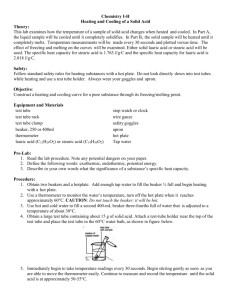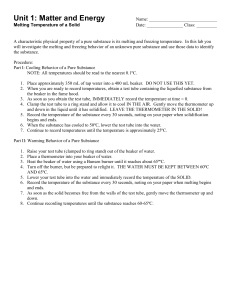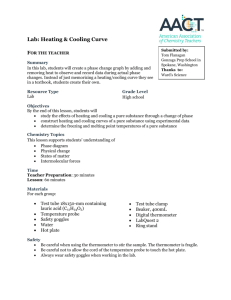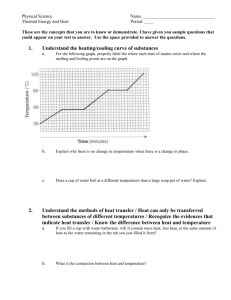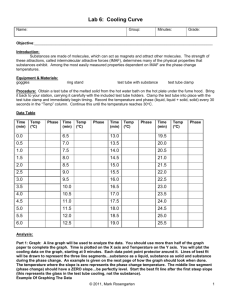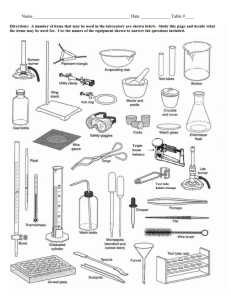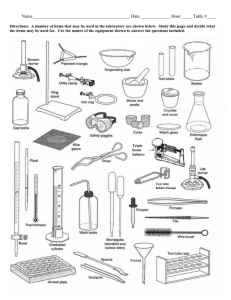Heating and Cooling Curves
advertisement
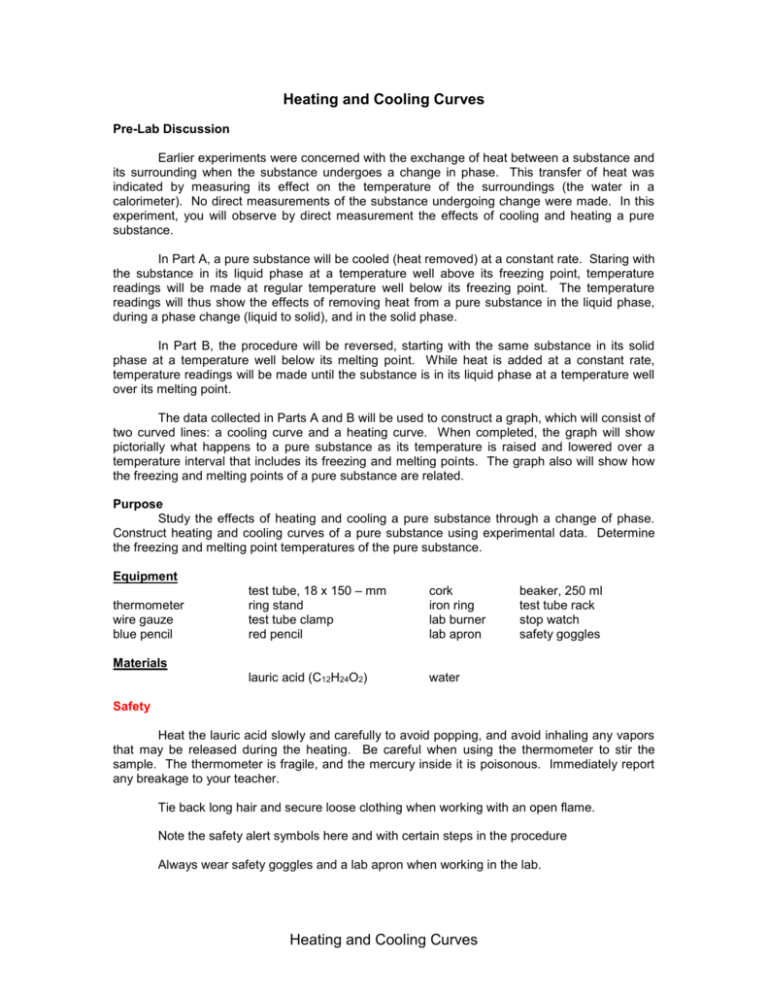
Heating and Cooling Curves Pre-Lab Discussion Earlier experiments were concerned with the exchange of heat between a substance and its surrounding when the substance undergoes a change in phase. This transfer of heat was indicated by measuring its effect on the temperature of the surroundings (the water in a calorimeter). No direct measurements of the substance undergoing change were made. In this experiment, you will observe by direct measurement the effects of cooling and heating a pure substance. In Part A, a pure substance will be cooled (heat removed) at a constant rate. Staring with the substance in its liquid phase at a temperature well above its freezing point, temperature readings will be made at regular temperature well below its freezing point. The temperature readings will thus show the effects of removing heat from a pure substance in the liquid phase, during a phase change (liquid to solid), and in the solid phase. In Part B, the procedure will be reversed, starting with the same substance in its solid phase at a temperature well below its melting point. While heat is added at a constant rate, temperature readings will be made until the substance is in its liquid phase at a temperature well over its melting point. The data collected in Parts A and B will be used to construct a graph, which will consist of two curved lines: a cooling curve and a heating curve. When completed, the graph will show pictorially what happens to a pure substance as its temperature is raised and lowered over a temperature interval that includes its freezing and melting points. The graph also will show how the freezing and melting points of a pure substance are related. Purpose Study the effects of heating and cooling a pure substance through a change of phase. Construct heating and cooling curves of a pure substance using experimental data. Determine the freezing and melting point temperatures of the pure substance. Equipment thermometer wire gauze blue pencil test tube, 18 x 150 – mm ring stand test tube clamp red pencil cork iron ring lab burner lab apron lauric acid (C12H24O2) water beaker, 250 ml test tube rack stop watch safety goggles Materials Safety Heat the lauric acid slowly and carefully to avoid popping, and avoid inhaling any vapors that may be released during the heating. Be careful when using the thermometer to stir the sample. The thermometer is fragile, and the mercury inside it is poisonous. Immediately report any breakage to your teacher. Tie back long hair and secure loose clothing when working with an open flame. Note the safety alert symbols here and with certain steps in the procedure Always wear safety goggles and a lab apron when working in the lab. Heating and Cooling Curves Procedure Part A Fill a 250 ml beaker ¾ full of cold tap water Obtain a corked test tube containing a sample of the substance to be studied. Clamp the test tube to a ring as shown in fig. 1 (insert pic) Remove the cork. Heat the sample carefully by moving the burner gently back and forth as shown in figure 1. CAUTION, before heating, check to see that the mouth of the test tube is pointing away from yourself and others. As soon as the sample begins to melt, remove the heat and place a thermometer in the sample. Using the thermometer to stir the sample, resume heating gently until the sample is completely melted. Do not overheat. The final temp of the sample should be about 60oC. if it is higher, wait until it drops to this temp before proceeding with step 5. at this point in the experiment, one partner will call out the time every ½ minute and will recorded temperature data in the data table. The other partner will read off the temperature of the sample at each ½ minute interval. When the temperature of the sample is 60oC, set the time at 0 minutes. Immediately immerse the test tub into the cold water bath, making sure the entire sample, but not the entire test tube, is below the surface of the water (18-2) (insert pic) The recording partner will call out the time every ½ minute. The second partner will use the thermometer to stir the sample constantly as long as some liquid remains. At each half minute interval, this partner ill read the temperature to the recording partner. Continue this procedure until the temperature of the sample reaches 25oC. remove the test tube from the water and stand it in a test tube rack. Part B Heating Curve Using a setup like that shown in figure 3, but without the test tube in the beaker, heat the water in the beaker to a temp of about 70oC. remove the heat. (insert pic) While the water was being heated, the sample in the test tube was cooling to approximately room temperature. Set the time at 0 minutes when you record the exact temperature of the sample and immerse it below the water level in the hot water bath. Read and record the temperature of the sample ever ½ minute as in part A. As soon as the thermometer is free to move, it should be used to stir the solid liquid mixture. Continue stirring and recording the temperature at half min intervals until the temperature of the sample reaches 50oC. Remove the thermometer and clean it. Remove the test tube from the water bath and allow it to cool. Replace the cork in the test tube and return the sample to your teacher. Insert table Insert graph Heating and Cooling Curves Conclusions and questions 1. Referring to your graph, determine the freezing point of lauric acid. How does this temperature compare with the melting point temperature of the same substance? 2. Explain the diagonal parts of the cooling curve in terms of changes in kinetic and potential energy. Do the same for the horizontal portions of the cooling curve. 3. What phase changes are exothermic? Endothermic? 4. In which phase of a substance do its particles have the greatest average kinetic energy. Heating and Cooling Curves
